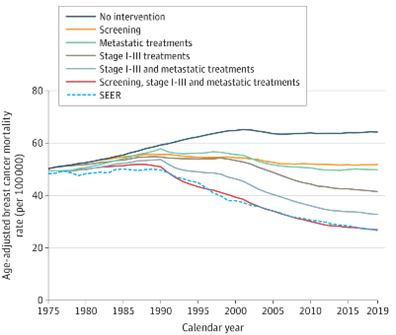Who We Are
CISNET consists of over 200 members at approximately 30 different academic institutions in the U.S., Europe, and Australia. We are interdisciplinary teams of decision modelers, statisticians, health economists, epidemiologists, computer scientists, clinicians and more. Funding is provided by the National Cancer Institute (NCI) through a competitive grant process, and we work cooperatively with NCI staff in the Division of Cancer Control and Population Sciences and Division of Cancer Prevention.
Highlights
The CISNET Lung Working Group published a modeling analysis of the 2019 Tobacco 21 law across the US in JAMA Health Forum on December 20th, 2024 which marks the 5th anniversary of the signing of the federal Tobacco 21 law. Listen to lead author Dr. Jamie Tam discuss the study and its implications on the JAMA Health Forum podcast
. Explore findings from this study interactively for each state through the TCP tool
website.
CISNET investigators, in collaboration with Drs. Goddard and Castle, the Directors of DCCPS and DCP, quantified the impact of prevention, screening, and treatment on cancer deaths averted from 1975-2020 and projected the impact of prevention and screening on deaths averted and life years gained from 2021-2045.
 In this recent analysis published in JAMA, four CISNET models were used to estimate the contribution to the reduction in breast cancer mortality of changes in breast cancer screening and treatment since 1975.
In this recent analysis published in JAMA, four CISNET models were used to estimate the contribution to the reduction in breast cancer mortality of changes in breast cancer screening and treatment since 1975.
Cancer Sites
Models focus on the natural course of the disease and will address questions on its prevention, diagnosis, treatment, and surveillance.
Models focus on critical early detection and clinical management issues, and are being used to evaluate mortality outcomes, harms and costs of rapidly evolving cancer control paradigms.
Models focus on the natural history of human papillomavirus (HPV) and cervical carcinogenesis, the impact of HPV vaccination and screening, the comparative effectiveness of HPV vaccination and screening strategies, and approaches to improve cervical cancer outcomes.
Models focus on the natural history of the disease and the impact of interventions, including targeted screening and treatment, on mortality.
Models are being used to produce innovative changes to gastric cancer care with a focus on high-risk populations that bear the greatest gastric cancer burden.
Models focus on tobacco control in the US and other countries, lung cancer screening and early detection, targeted therapies and immunotherapies, and investigation of the synergistic impacts of those strategies.
Models focus on the natural history of the disease and the impact of novel strategies in preventing and treating multiple myeloma, with the goals of reducing its burden and improving outcomes.
Models focus on investigating risk-based screening and treatment strategies and approaches for improving outcomes.
Models are being used to inform strategies for reducing uterine cancer incidence and mortality by improving prevention, screening, and treatment.